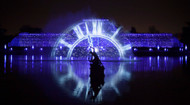Kew Gardens | Londons Royal Botanic Gardens | Dallaswear
Posted by Callum McCrimmon on 1st Jan 1970

Kew Gardens
At present, due to coronavirus restrictions, Kew Gardens are open to a limited number of visitors. The Gardens are operating a time slot system where visits need to be booked in advance. You are advised to travel there only if it is safe to do so. Anyone who has not booked a time slot, including members will be refused entry.
Kew Gardens is an UNESCO (United Nations Educational, Scientific and Cultural Organisation) World Heritage Site. The gardens were created in 1759, designed by Charles Bridgeman, William Kent, Capability Brown and William Chambers. The purpose of the Gardens was to study botany and ecology.

There are 50,000 living plants spread across the UNESCO Heritage Site. 14,000 trees representing 2000 species cover two thirds of the Gardens. Some of the trees are as old as the Gardens themselves. There are varieties from all over the world and some that are found nowhere else in Britain. Such a collection means that scientists at the Gardens can gather the knowledge needed to protect the habitats of both native and international species. The Gardens remain an important place for the scientific study of plants. There are over 350 scientists whose research includes the discovery and identification of new species. Their work also involves urgent research into the effect of climate change on global habitats and the effects it has on all of us. Behind the scenes there are huge collections of plants and seeds in all their forms (8.5 million items) which are stored for scientific research and conservation. It has been estimated that the thousands of trees on the site are responsible for the “drawdown” of about 8.6 tonnes of carbon dioxide from London’s air every year. Not only are the Gardens a beautiful place to visit, they are also good for the air quality of London.

As well as the abundance of trees from all over the world there are plenty of other ecological representatives in Kew Gardens numerous conservatories. The Princess of Wales Conservatory for example, has a total of ten computer-controlled climate zones. One of the most amazing sights includes the giant waterlily Victoria Amazonica which floats in the waters of the wet tropical zone. Stunning white flowers which open at sunset turn bright pink by morning, once pollinated having filled the air with the most amazing perfume.
There are areas of statuesque cacti and succulents in the tropic dry zone which leads on to the next steamy tropical zone where beautiful orchids, in an array of colours, flourish in every direction.
Another zone in the Princess of Wales Conservatory is dedicated to carnivorous plants such as the Venus flytraps which feeds on insects.
In Spring there are stunning displays of bluebells and crocuses. A little later in the year Rhododendrons in all colours put on a lovely display. There are formal, scent filled rose gardens, and under non-coronavirus conditions there are often special events which take place throughout the year. The Royal Botanical Gardens Kew are well worth a visit for Londoners and tourists alike. Children are catered for with new play areas, the tree walk which takes you high up in to the tree tops. There is a giant badger sett to explore and for nature lovers there are lots of ducks, peacocks, wild native birds and parakeets. There are numerous cafes, restaurants and shops selling high quality items such as books, preserves and jewellery.

